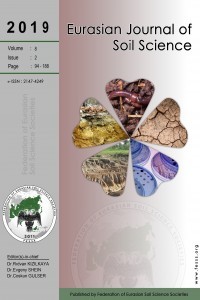
Eurasian Journal of Soil Science
Yazarlar: Gülay Karahan, Sabit Erşahin
Konular:-
DOI:10.18393/ejss.2016.1.030-038
Anahtar Kelimeler:Saturated hydraulic conductivity,Soil morphological properties,Multiple linear regression,Pedotransfer functions,Soil stickness,Soil structure
Özet: Many studies have been conducted to predict soil saturated hydraulic conductivity (K s) by parametric soil properties such as bulk density and particle-size distribution. Although soil morphological properties have a strong effect on K s, studies predicting K s by soil morphological properties such as type, size, and strength of soil structure; type, orientation and quantity of soil pores and roots and consistency are rare. This study aimed at evaluating soil morphological properties to predict K s. Undisturbed soil samples (15 cm length and 8.0 cm id.) were collected from topsoil (0-15 cm) and subsoil (15-30 cm) (120 samples) with a tractor operated soil sampler at sixty randomly selected sampling sites on a paddy field and an adjecent grassland in Central Anatolia (Cankırı), Turkey. Synchronized disturbed soil samples were taken from the same sampling sites and sampling depths for basic soil analyses. Saturated hydraulic conductivity was measured on the soil columns using a constant-head permeameter. Following the K s measurements, the upper part of soil columns were covered to prevent evaporation and colums were left to drain in the laboratory. When the water flow through the column was stopped, a subsample were taken for bulk density and then soil columns were disturbed for describing the soil morphological properties. In addition, soil texture, bulk density, pH, field capacity, wilting point, cation exchange capacity, specific surface area, aggregate stability, organic matter, and calcium carbonate were measured on the synchronized disturbed soil samples. The data were divided into training (80 data values) and validation (40 data values) sets. Measured values of K s ranged from 0.0036 to 2.14 cmh -1 with a mean of 0.86 cmh -1. The K s was predicted from the soil morphological and parametric properties by stepwise multiple linear regression analysis. Soil structure class, stickiness, pore-size, root-size, and pore-quantity contributed to the K s prediction significantly (P<0.001, R 2 = 0.95). Soil morphological properties can be used along with basic soil properties in predicting K s.